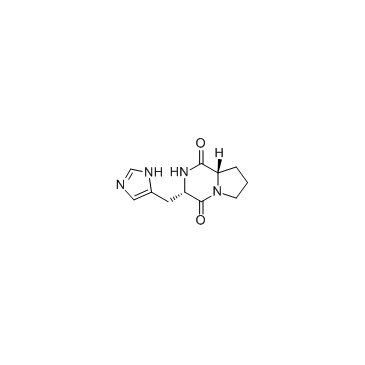53109-32-3
| Name | 3-(1H-imidazol-5-ylmethyl)-2,3,6,7,8,8a-hexahydropyrrolo[1,2-a]pyrazine-1,4-dione |
|---|---|
| Synonyms |
cyclo-His-Pro
Histidylproline dioxopiperazine Cyclo(his-pro) |
| Description | Cyclo(His-Pro) is a cyclic dipeptide structurally related to tyreotropin-releasing hormone. Cyclo(His-Pro) could inhibit NF-κB nuclear accumulation. |
|---|---|
| Related Catalog | |
| Target |
NF-κB Human Endogenous Metabolite |
| In Vitro | Cyclo(His-Pro) is a cyclic dipeptide derived from the hydrolytic removal of the amino-terminal pyroglutamic acid residue of the hypothalamic thyrotropin-releasing hormone. Cyclo(His-Pro) is ubiquitous in the central nervous system and is a key substrate of organic cation transporters, which are strongly linked to neuroprotection. The cyclic dipeptide can also cross the brain-blood-barrier and, once in the brain, can affect diverse inflammatory and stress responses by modifying the Nrf2-NF-κB signaling axis[1]. Cyclo(His-Pro) inhibits NF-κB nuclear accumulation induced by paraquat in rat pheochromocytoma PC12 cells via the Nrf2/heme oxygenase-1 pathway[2]. |
| In Vivo | Mice that receives cyclo(His-Pro) pre-treatment shows a significant decrease in the oedematogenic response, confirming that the cyclic dipeptide can exert anti-inflammatory effect[2]. Cyclo(His-Pro) exerts in vivo anti-inflammatory effects in the central nervous system by down-regulating hepatic and cerebral TNFα expression thereby counteracting LPS-induced gliosis. Moreover, by up-regulating Bip, cyclo(His-Pro) increases the ER stress sensitivity andtriggers the unfolded protein response to alleviate the ER stress[3]. |
| Cell Assay | Immortalised murine microglial BV2 cells are incubated for 24 h with 50 μM cyclo(His-Pro), and then exposed to IL-6 (5 ng/mL) for 24 h. Live cells were counted by hemocytometer and viability assessed by the conventional MTT reduction assay after washing the cells with PBS[2]. |
| Animal Admin | Mice: Cyclo(His-Pro) anti-inflammatory effect is determined by topical application on the right ear of the second group (thirty C57BL/6 mice) of 1.8 mg/ear of cyclo(His-Pro) 30 min prior to TPA. Ear thickness is measured before and after induction of the inflammatory response by a micrometre[2]. |
| References |
| Density | 1.36g/cm3 |
|---|---|
| Boiling Point | 650.3ºC at 760mmHg |
| Molecular Formula | C11H14N4O2 |
| Molecular Weight | 234.25400 |
| Flash Point | 347.1ºC |
| Exact Mass | 234.11200 |
| PSA | 78.09000 |
| Storage condition | -20°C |
